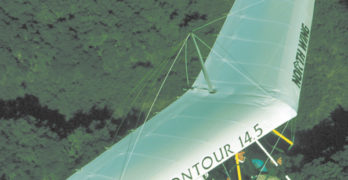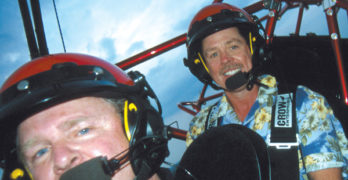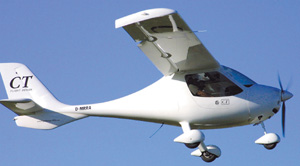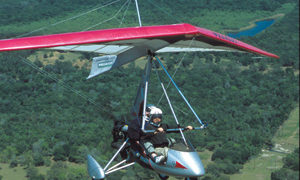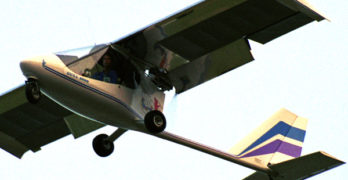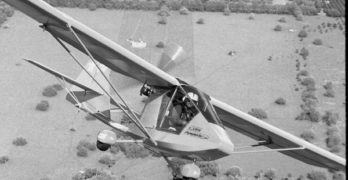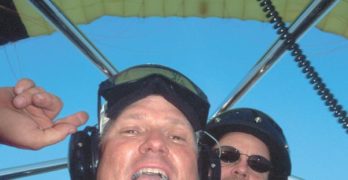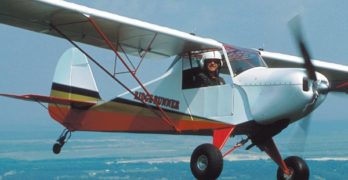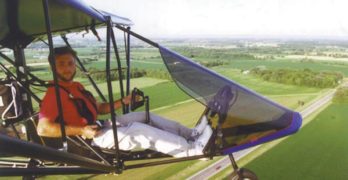North Wing Design has a history that stretches back into the mid-1980s when 23-year-old owner Kamron Blevins started making hang glider wings. After gaining experience with other companies and dabbling with his own ideas along the way, Blevins started North Wing Design in 1996 to provide trike wings.
His timing was good. After years of work to encourage Americans to consider trikes, various suppliers – many from Europe – were pleased to see their efforts pay off. Trike numbers began to increase about the time North Wing Design got into business. At first, Blevin’s new company created specially built trike wings for several chassis suppliers and the enterprise grew.
With increasing sales of wings to others and with a rising tide of trike interest lifting all manufacturers, North Wing Design decided to go all the way. Their first full trike ultralight offering in 1999 was the Maverick, a slick single-seater that met FAR Part 103 parameters with a Rotax 447 (see “Pilot’s Report: North Wing Design’s Maverick Trike,” September 1999 Ultralight Flying!
Search Results for : Electric
Not finding exactly what you expected? Try our advanced search option.
Select a manufacturer to go straight to all our content about that manufacturer.
Select an aircraft model to go straight to all our content about that model.
Destiny Powered Parachutes
In recent months, several industry observers have noted that powered parachutes’ sales appear to be stronger than fixed-wing sales. Many visitors count a large number of powered parachute manufacturers at airshows. Insiders hear rumors about the large volume of engines these companies are buying. Perhaps you’ve even said, “There’s one flying at my home field now.”
Much like trikes before them, the sales of powered parachutes (and powered paragliders) seem to be increasing. Most new flying machine types have their day, and currently powered parachutes appear to be enjoying a great run.
Growing Segment
Despite the fact that the planet supports only a couple million pilots, aviation is highly segmented. Flyers in America enjoy the broadest choices imaginable with aircraft of every description. This incredible diversity is vast enough that we tend to focus only on the types of flying machines that interest us (or that we can afford).
The concept of a parachute (canopy) acting as your wing isn’t particularly new.
Fixed -Wing or Flex-Wing
This month I wrote a pilot’s report about two widely different aircraft, both of which are imported by Rollison Airplane Company. Here’s how I handled it.
Every “Ultralight Flying! Pilot’s Report” has common elements: a main article, photos and photo legends, specifications, and our exclusive “Report Card.” Because the two subject flying machines are so different this month, I’ve prepared a “Report Card” for each aircraft. I did the same for specifications as the standard and optional features obviously differ too much for grouping.
In the main article, I take alternate looks at the two flying machines as a way to observe their differences, but further how they each have their benefits.
I also selected more photos – even though Ultralight Flying! reports regularly present many photos of ultralights being reviewed as readers often say that photos are a key informative element.
Because reviewing two different craft makes for a longer pilot report, I’ve somewhat abbreviated both the main article and the twin “Report Cards.”
Quite a few general aviation pilots recognize that ultralights offer a different way to fly| and that’s precisely what they like about them.
Flex-Wing or Fixed Wing
This month I wrote a pilot’s report about two widely different aircraft, both of which are imported by Rollison Airplane Company. Here’s how I handled it.
Every “Ultralight Flying! Pilot’s Report” has common elements: a main article, photos and photo legends, specifications, and our exclusive “Report Card.” Because the two subject flying machines are so different this month, I’ve prepared a “Report Card” for each aircraft. I did the same for specifications as the standard and optional features obviously differ too much for grouping.
In the main article, I take alternate looks at the two flying machines as a way to observe their differences, but further how they each have their benefits.
I also selected more photos – even though Ultralight Flying! reports regularly present many photos of ultralights being reviewed as readers often say that photos are a key informative element.
Because reviewing two different craft makes for a longer pilot report, I’ve somewhat abbreviated both the main article and the twin “Report Cards.”
Quite a few general aviation pilots recognize that ultralights offer a different way to fly| and that’s precisely what they like about them.
Single-Seat Gull 2000
In a flying world that seems to think a 2-seater is mandatory, Mark Beierle has released another single-place ultralight. And what a sweet ultralight it is.
I love the Thunder Gull series of ultralights. When people ask me what I personally like of the hundreds of ultralights evaluated, the Thunder Gull always springs to mind (among a few other designs). My interests may not be your interests, but I’ll bet most pilots would love to fly the Gull 2000.
Offered for sale here in the new millennium, the Gull 2000 is an appropriate name that seemed well aimed at lots of American ultralight enthusiasts.
Welcome to Gull 2000
For the new century, the Gull 2000 adds to, rather than replaces the older models from Earthstar Aircraft. The company will still sell their Thunder Gull J single-seater and their little-publicized Soaring Gull, which uses a very small engine and long wings to create something of a motorglider.
Dope and Fabric Hawk Arrow
One of the ultralight industry’s longest enduring designs is the Hawk. First offered in 1982, the Hawk flies today – 15 years later! – in essentially the same form. A few years ago the Arrow name was added to a refined version (becoming the Hawk Arrow) but the basics didn’t change. The original became the Hawk Classic.
So, why are we reporting on it? Two reasons quickly spring to mind.
First, the plane deserves it. This is an excellent little bird that has delivered a lot of aerial fun to virtually a generation of pilots. However, new pilots enter the community between articles and these aviators need to know this design still works well today like it did way back in the early ’80s when ultralights were new on the aviation scene.
Secondly, this isn’t the same Hawk.
Oh, it still looks much the same. Such a statement is hardly fair, though, to the many refinements that showed up on the plane I flew for this report.
Powrachute
Like a poised cat, restrained energy waiting for its opportunity, Powrachute sprang into the powered parachute industry and snapped up a share of this fast-growing aviation segment. In just a couple of years, the Kansas company has found some 300 buyers of their distinct ultralight.
Given their approach to the industry, perhaps using a “spokes tiger” is highly appropriate. A feline named Noah is featured in the company’s ads and on its brochure. As with the unusual spelling of the corporate name, Noah helps Powrachute stand out in a crowd. (Personally, I thought the letters meant Pow’r-a-‘chute, spelled in the shorthand way of vanity license plates.)
Until recently, the Kansas company offered a single 2-seat model – the PC2000 – which could be configured with various options. The PC2000 is a new design “for the 21st century.” However, despite its newness, even the PC2000 changed rather dramatically to add rollover protection which the company calls Frontal Fuselage Bars.
Rocky Mountain Wings Ridge Runner
One of the all-time successes in the world of kit-built light aircraft is the Kitfox. Challenged in terms of success by Vans Aircraft’s RV series, many Kitfox aircraft have been sold. Denney Aerocraft, the original manufacturer of the Kitfox design, never considered a single-place machine. Why would they? Even pumping out 60 planes a month in their heyday of the early 1990s, they were barely keeping up production quotas.
Avid Aircraft, producer of the Avid Flyer (the forerunner of the Kitfox) also never pursued a single-place model. In the early 1990s Avid was also going strong. But by early 2000, things looked a bit different.
Dan Denney sold Denney Aerocraft to Phil Reid in the early 1990s, and the company was renamed SkyStar Aircraft. The company was then sold again to Ed Downs and partners, with the company name remaining SkyStar Aircraft. By this time, the Kitfox design became somewhat saturated, and other creations muscled into the limelight of pilot attention.
Aero-Lite 103
Manufacturers in the ultralight industry believe they know what pilots want or what they will buy, anyway. A 2-seater is usually part of the answer. But, in fact, many industry watchers are wrong.
While many observers make the statement, ÒNinety percent of ultralights are 2-seaters,Ó statistics tell another story. Nearly 40% of ultralight and microlight aircraft sold in the U.S. are single-seaters, according to Ultralight Flying! magazineÕs surveys of manufacturers. Despite the polling results, however, those experts have a point. Two-seaters do represent the majority of ultralights and microlights sold.
Yet, just when you think 2-seaters are going to take over the whole market, along comes a new trend. Maybe it was FAAÕs lack of action on Part 103 changes, or maybe manufacturers simply decided to take on the challenge of staying within 103Õs tight weight, speed and fuel quantity restrictions. Whatever the correct answer, it doesnÕt change the fact of a growing population of Part 103 ultralights.
Titan Tornado
An Experimental ‘fighter jet’ that any pilot could love That vast majority of general aviation pilots who won’t even think about building their own plane has missed quite a revolution.
The FAA says approximately 25,000 aircraft are registered as Experimentals. That’s 15% of the GA fleet.
Building isn’t what it used to be. You no longer need to master the skill of reading engineering prints (plans), nor must you search high and low for parts.
These days, most registered Experimental aircraft are built from kits. Many are well-fabricated packages that can be assembled in just a few hundred hours. That can mean as little as two or three hours a night, two to three days a week, for about a half-year. Not a bad investment for a truly unique airplane.
One sport pilot who enjoys flying his creations is Minnesota resident Al Reay. For Reay, building is a means to an end.


